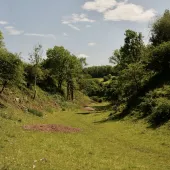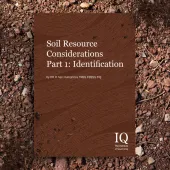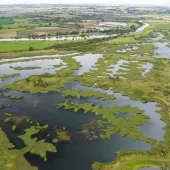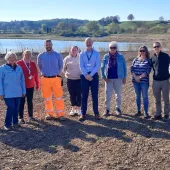The National Design Guide
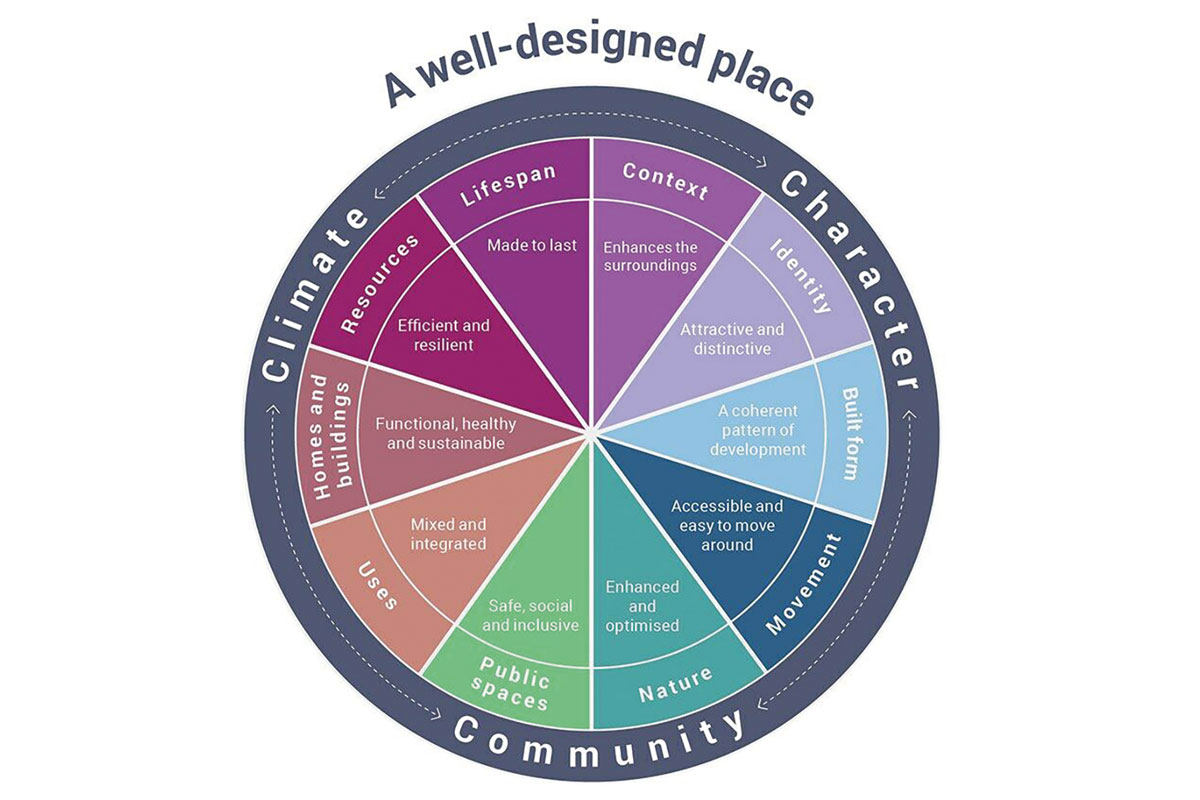
First published in the May 2022 issue of Quarry Management
What does good design mean in the context of minerals restoration? Ben Siddle reflects on two years as graduate planner with The Banks Group
As set out in the Secretary of State for Housing and Communities’ written statement on 20 July 2021, the Government is seeking to raise the standards of design and quality of new development in its latest updates to the National Planning Policy Framework (NPPF).
Both beauty and place-making are key themes in the new NPPF, which highlights that local planning authorities should prepare design guides consistent with the principles set out in the National Design Guide, published in January 2021. The National Design Guide itself establishes 10 principles which underpin the theme of good design, as set out in the NPPF.
I joined The Banks Group in September 2019 and spent two years working as a graduate planner with Banks Mining. In this article, I would like to reflect on the past two years and on what I have learned about the important role that mineral extraction schemes have to play in achieving well-designed places. Despite this, the national design guidance is not specifically designed to cover minerals projects and it fails to recognize the characteristics of mineral extraction and restoration schemes.
In my view, each of the 10 design principles have already been achieved by the industry for some time. To demonstrate this, I would like to focus on four of the 10 principles (Context, Identity, Nature, and Lifespan) and apply them to the tree planting and management taking place at Banks Group’s former Brenkley Lane surface mine, which has been restored and landscaped.
Woodland planting and management represent only two of several elements which comprise the sophisticated restoration, aftercare, and landscape strategy for Brenkley Lane. However, they have an important role to play in addressing key issues in relation to design at both national and local levels.
Restoration strategy and aftercare at Brenkley Lane
The Banks Group are a family business, established in 1976, with a long-held commitment to ‘Development with Care’ that lies at its heart and contains four key commitments: to our environment, to our communities, to our people, and to our business partners. The commitment to our environment involves aiming to achieve the highest practicable environmental standards through innovation and continuous improvement.
Brenkley Lane surface mine is split between the boundaries of Newcastle City Council and Northumberland County Council, and the southern half of the site lies within the jurisdiction of the former. In April 2010, planning permission was granted by Newcastle City Council for the first phase of mineral extraction on land to the north of Brenkley, on the northern edge of Newcastle, and for the phased restoration of the site. An eastern extension to the Brenkley Lane site was approved in July 2015.
Banks set out exactly how the land will be landscaped after mineral extraction operations are completed on various parts of each site. Each site has its own unique and detailed restoration strategy devised by the company’s in-house landscape architect, which sets out how the site will be restored and landscaped to the highest environmental standards.
Following restoration, Brenkley has now entered the process of ‘aftercare’. This involves landscaping work including soil cultivation, under-drainage, seeding, fencing, woodland and hedgerow planting, and the formation of new wetlands and meadows. Aftercare is undertaken at every one of Banks’ restored minerals sites and involves continuous, sensitive treatment and management of the restored landscape to make sure that the natural environment thrives. The aftercare period on the agricultural areas and woodlands at Brenkley Lane will last for a minimum of five years.
Newly planted trees face challenges and threats from the day they are planted, right through to the growth and maturity stages. These complex challenges require long-term, carefully considered solutions which the minerals industry is ideally placed to achieve.
Context: understanding the baseline position of the Brenkley Lane site and its surrounding context
Beauty is mentioned a lot throughout the revised NPPF. The definition of beauty will, at a local level, be underpinned by baseline studies and centred around the 10 characteristics of a well-designed place within the National Design Guide.
The first of these characteristics is ‘context’ and the guidance highlights that well-designed places are based upon a sound understanding of the features of the site and the surrounding context. Attributes not just of the site’s immediate surroundings, but also its local and regional ones need to be clearly understood and defined.
Banks have worked together with the landowners of the site, Blagdon Estate, since the formation of the business in the mid-1970s and this is a partnership which continues to the present day. The Banks Group’s ‘Development with Care’ approach, their long association with the local area, and the knowledge held by both Blagdon and Banks were pivotal in recognizing the need for improvements to several features and elements which made up the character of the site and its surrounding context.
Brenkley Lane was considered to be of moderate landscape condition which reflected the overall poor health of the trees on site. Evidence of past subsidence due to historical deep underground mining activity had altered the landform and drainage patterns. Many of the trees were found to be stag headed, indicating stress and root death due to changes of soil structure and drainage conditions. In some parts, this could also have been exacerbated due to deep ploughing having caused root severance in the past.
Likewise, beyond the site boundary, the Castle Ward (within which Brenkley Lane lies) had a relatively low degree of tree canopy cover compared with other wards in the city. This was elucidated by the findings of Newcastle City Council’s 2018 iTree Survey, which identified that Castle Ward possessed the joint-lowest volume of tree canopy cover of all wards in the city boundary.
This matters because trees have the potential to enhance the environmental quality of a city and deliver significant physical, social, and environmental benefits, such as mitigating climate change and controlling run-off from heavy rain. Tree canopy cover in Castle Ward stood at only 10.2%, far lower than the city average of 18.1% and three times lower than Parklands Ward at 30.6%.
Such low canopy cover in the Castle Ward reflects the agricultural use of the surrounding land, with a range of grazing and crops. Delivering biodiversity enhancements within a predominantly agricultural setting represented a complex challenge for both Banks and Blagdon Estate. However, both parties recognized the positive responses that could be made not only to the features within the Brenkley Lane site, but also its surrounding context.
Identity: Responding to local character and identity
Identity, within the context of good design, comes not only from the existing built form, but also by landscape precedents. The character of a place derives from the way that buildings, streets and spaces, landscape, and infrastructure combine and how people experience them, according to the guidance.
Brenkley Lane, having undergone mineral extraction and subsequent restoration, benefits from new and positive elements of character which, I believe, will help to strengthen a positive and coherent identity that both residents and local communities can identify with not only during the aftercare period, but also beyond this.
Overall, including in-hedge trees, more than 12,300 new trees have been planted at the Brenkley Lane site. It was with great interest, therefore, that last year I read that Newcastle City Council, in their revised trees policy, ‘Trees Newcastle’, set a target of increasing canopy cover across the whole of its city boundary from 18.1% to 20% by 2050.
At first glance, this may appear to be a difficult target to achieve on a city-wide basis, as several constraints (such as the availability of planting land and funding) can determine the number of trees that can be planted. Yet one minerals site is able deliver this city-wide target almost entirely on its own.
Brenkley Lane is just one site, in one ward within the city, yet it is making a contribution of more than 60% to the Council’s new tree-planting target. The Council’s primary target of increasing tree canopy cover from 18.1% to 20% equates to around 19,000 new trees being delivered over a 32-year period. Mineral restoration schemes provide these unique opportunities to create an entirely new landscape and enhancements from what existed on the land before.
However, this only scratches at the surface. Once established, these woodland areas will combine with improved public rights of way in and around the site, as well as new ecological areas and interpretive material to provide a more interesting walking experience at the site.
The restored and landscaped Brenkley Lane site, once established, will be not only attractive, but also distinctive. It will encourage increased levels of usage, with inherent associated public health and well-being benefits stimulated in the long term. Hard-landscaping elements such as footpaths, tracks, fencing, stiles, and signage will combine with soft landscaping to create a character that suits the site’s context, its history, how we live today and how we are likely to live in the future.
Nature: incorporating new natural features into a multifunctional network
Nature is viewed by the national design guidance as a critical component of well-designed places, which integrate natural features and prioritize nature so that diverse ecosystems can flourish, thereby ensuring a healthy natural environment that supports and enhances biodiversity.
Although the importance of the minerals industry in achieving this aim is ignored in the design guidance, the different range of tree species being provided at Brenkley Lane will ensure the restored landscape plays a multifunctional role. New woodland planting at the site has an important role to play in not only providing carbon sequestration, water storage and flood management, but also in delivering important new habitats.
Restored mineral sites provide an opportunity to create an enhanced landscape where rare and endangered species can thrive, whilst also addressing and responding to climate change. Some of the countless achievements of the minerals industry in supporting nature recovery over the last 50 years have been captured within a new brochure published by the Mineral Products Association (MPA)[1].
From an ecological perspective, the primary driver has been to enhance habitat connectivity over the wider area. The restoration of Brenkley, along with other Banks minerals sites at Delhi and Shotton on the Blagdon Estate, together unlocked a unique opportunity to develop a wider-scale landscape and ecology plan. To the north of Brenkley lies the river Blyth corridor, and important habitats lie to the south (Prestwick Carr SSSI) and west (Big Waters SSSI).
A range of native deciduous species has been selected as a means of enhancing the wildlife value of the site and the trees potential success on the newly restored land. In addition, careful consideration has been given to the layout, form, appearance, and details of proposed planting.
For example, new trees and shrubs are predominantly planted as 45–60cm transplants. The main canopy trees such as oak and beech have been randomly planted in groups of five to 20. Shrub species themselves are concentrated on the woodland edges, with small groups of between three and five dispersed within the main woodland and interior glades in accordance with Forestry Commission best practice.
The support that species evenness (number present) and species richness (abundance of species) can provide to biodiversity in the wider landscape cannot be underestimated. The greater the range and number of plant species, the healthier an area’s ecosystem is, according to the Woodland Trust[2]. Robust and layered habitats at Brenkley will help to provide different conditions to suit the special needs of a variety of species, thereby creating a more biodiverse area compared with what existed before.
Lifespan: Sustaining beauty over the long term
The final chapter of the design guidance, Lifespan, emphasizes that well-designed places are robust, durable, and easy to look after. Good management is seen as integral to sustaining the resilience, attractiveness, and beauty of a particular place.
Management and maintenance responsibilities for both the restoration and aftercare phases of Brenkley Lane are clearly defined and the activities which take place within the five years following restoration are vital to the success of healthy mature woodland. Full details of the restoration and aftercare arrangements for the site are provided within the Restoration and Aftercare Statement.
In the early establishment years, weed control is one of the most important management operations that determines the success of new planting. To this end, a weed-free zone of 1m diameter is being maintained around each plant at Brenkley Lane by hand and weed control is being undertaken utilizing a suitable herbicide. Other operations include checking stakes, canes and ties and inspecting and adjusting guards and shelters where necessary.
Overall, the aim of aftercare management is to create and maintain newly planted areas of native tree and shrub planting in such a way as to ensure their development into healthy mature woodland, with diverse composition and height structure. Clear and sustained management of the site will ensure that the beauty of the restored site will be sustained in the long term.
Conclusion
Woodland planting and maintenance at Brenkley Lane will help to overcome key challenges in design as detailed at both central government and local authority level. As the MPA notes, the minerals products sector was restoring land to support nature recovery decades before the term ‘net gain’ was coined and, in many ways, the industry has been ahead of the game.
Yet, at no point throughout the guidance is the role of the minerals industry acknowledged. This is unfortunate because Banks’ Brenkley Lane, Delhi, Shotton, and Bradley sites are all fantastic exemplars of what can be achieved in the restoration and landscaping of former mineral extraction sites. They incorporate the principles of good design and are an excellent example of the care that The Banks Group take in the work they do.
I have been inspired by the dedication and ethos of my colleagues and I feel proud to have played a small role over the last two years in helping to manage planning matters during the operation and restoration of both Brenkley Lane and Shotton in my home county of Northumberland. I will take these experiences with me as I move forward in my career.
REFERENCES
- Mineral Products Association (2021): Quarries & Nature: A 50 year success story.
- Woodland Trust (2021): Why are trees important for diversity?
- Subscribe to Quarry Management, the monthly journal for the mineral products industry, to read articles before they appear on Agg-Net.com



